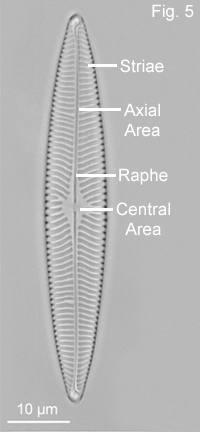|
|
For the purpose of computer recognition, it is possible to split valve
morphology into component groups of characters (= features). The outline
of the valve is an obvious source of morphological characters; for example,
size is an important identifier (but see the life-cycle related changes
in size, below). Shape is another suite of characters that are very important
for identification. Symmetry is one of its components: the greatest proportion
of diatom genera are bilaterally symmetrical about two orthogonal axes
(the apical and transapical axes, Fig. 3, Fig. 4A); most are also symmetrical
about the third orthogonal axis as well (the pervalvar axis), but this
is of less importance since automatic identification will be concerned
with diatoms in valve view. A much smaller number of genera are bilaterally
symmetrical about only one axis; this can be either the transapical (Fig.
4B) or the apical (Fig. 4C) axis, although some of the species included
are very nearly symmetrical in both planes; some bipolar genera have no
planes of symmetry, but rotational symmetry instead (Fig. 4D). A large
group of genera are more or less circular (Fig. 4E). Other components of
shape can be analysed mathematically: a simple measure of rectangularity
can be informative in some genera, while fitting the outline to a polynomial
expansion may be more appropriate in others, using each polynomial element
as a taxonomic character.
|

|
The pattern of ornamentation (Fig. 5) is the other major source of
identifiers in diatoms. Usually the valve is covered with a more or less
regular pattern of lines of skeletal pores (the striae), the periodicity
and angle of which have great significance. Another important character
is the presence or absence of a raphe (an elongated fissure through the
valve wall, involved in cell motility). Very small morphological details
such as the shape of the raphe endings are very important as sources of
taxonomic (i.e. classificatory) evidence, but in many cases they are not
essential for identification. However, the structure of the striae (the
main pattern-forming lines on the diatom) is important for both identification
and classification; whether they appear as more or less simple lines, or
composed of single or double rows of pores. Another very useful character
(for both processes) is how the pattern of striae changes over the valve
face and the shape of the axial and central area. |